Cannabis cultivators interested in getting the most out of their harvest must be equipped with an understanding of how important timing their harvest is, as well as the best ways to increase their overall yield.
There are several benefits to cultivating cannabis and industrial hemp. The legal cannabis market is growing rapidly and shows no signs of slowing down anytime soon. In 2021, the global cannabis market was worth $22.5 billion and is expected to reach over $82 billion by 2027.
For commercial growers, increasing and sustaining high yields from each harvest is necessary for business success. Knowing how to time your harvest and the best pruning techniques are the easiest ways to increase your yields and remain successful.
We cover everything a cannabis grower needs to know about timing your harvest and how to prune cannabis plants for maximum yields.
Understanding the Cannabis Growth Cycle
Understanding the cannabis growth cycle is central to understanding the importance of pruning and timing to increase yields. As cannabis plants grow and mature, they undergo several distinct stages. Generally, cannabis plants take anywhere from 10–32 weeks (about 3–8 months) to grow from a seed to a fully mature plant that is ready to harvest.
The cannabis growth cycle can be broken down into four stages:
- Germination (approximately 3–10 days)
- Seedling (14–21 days / 2–3 weeks)
- Vegetative (21–112 days / 3–16 weeks)
- Flowering (56–77 days / 8–11 weeks)
Monitoring plants throughout each stage of the growth cycle is critical to ensure a successful harvest with high yields. Seedlings, for example, prefer relatively moist conditions (65–80% humidity) and warm temperatures (72–79 °F), need very few nutrients (if any), and should be watered sparingly with a spray bottle to circumvent overwatering.
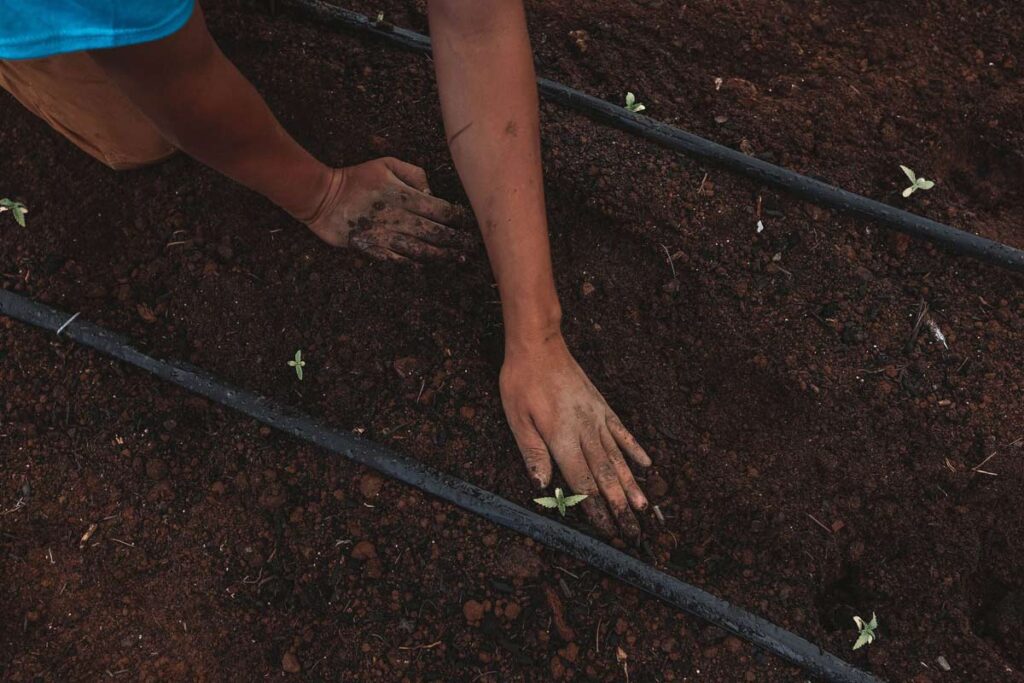
Where It All Begins: Germination and Seedling Stages
Typically, commercial growers plant cannabis seeds directly into soil or a growing medium such as coco coir or rockwool. The seeds are placed about ½ inch deep and then covered with soil or the selected medium. Another method would be using a small starter plug made from a material such as peat moss or compressed pellets. Here, the seed is placed in a small hole in the plug and then covered.
The seeds will begin to absorb moisture and swell, causing the outer shell to split open and reveal a taproot. Once the taproot emerges, it will start to grow downwards, anchoring the plant into the soil or its growing medium. With the right conditions, cannabis seeds will sprout and start the actual growth process. These conditions include moisture, temperature, and lighting.
The Vegetative Stage
During the vegetative stage, plant growth will increase exponentially, and it’s important to give plants exactly what they need. Cannabis plants in veg prefer:
- A relative humidity level of approximately 40–60%
- Proper nutrients on a regular schedule
- Healthy soil
- Pots that allow for ample growth to prevent them from becoming rootbound
- Regular watering
Keep in mind that most indoor growers leave plants in the vegetative stage for 4–8 weeks depending on the plants’ pot size. The longer plants are kept in the vegetative stage, the larger they will become, which will ultimately allow for higher yields when it comes time to harvest.
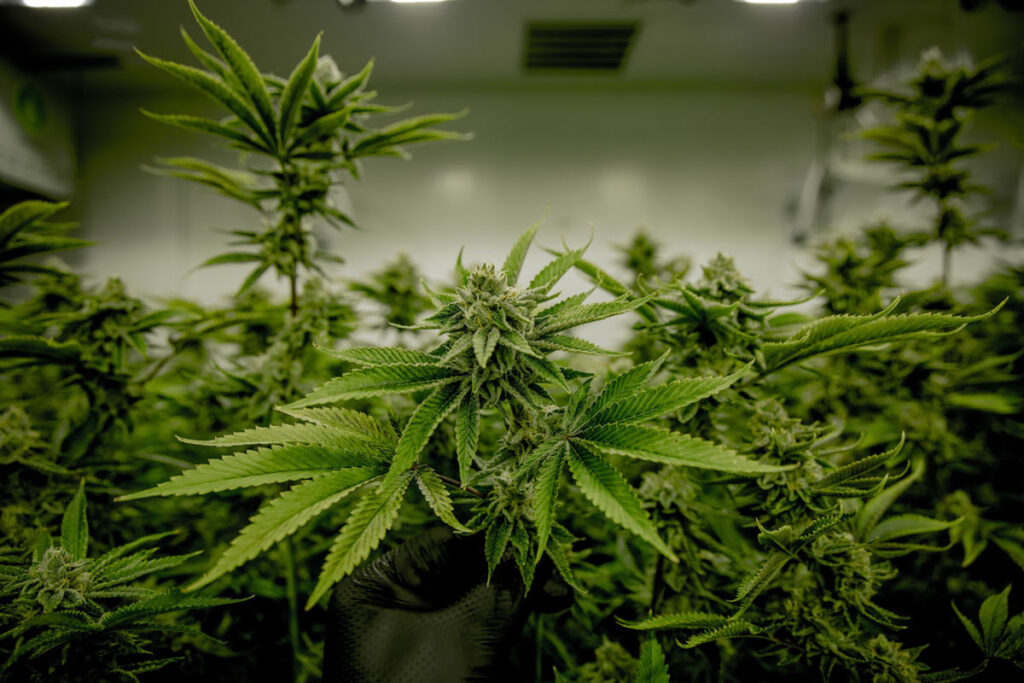
The Flowering Stage
Correctly monitoring and caring for plants during the flowering phase is crucial for ensuring high yields. Right before the flowering stage, plants should be transplanted into their final pot. During the flowering stage, cannabis prefers:
- A relative humidity level of 40–50%
- A regular dose of flowering nutrients
- A 12-hour light / 12-hour dark schedule if growing indoors
- Watering as needed to prevent drying out.
If growing indoors, it’s extremely important not to disturb the 12 hours of darkness. If the dark period is disrupted in any way, the plant can become thrown off balance, and it could delay flowering.
Aside from closely monitoring cannabis plants throughout each growth stage, timing your harvest once plants have matured is also key to attaining the highest yields. There is a fairly narrow window, in terms of time, when you can harvest your buds if you want to get the highest quality and potency. This window can range from a few days to a week long.
If you harvest too early in the flowering stage, the buds won’t be fully developed and won’t contain peak THC levels. If harvested too late, buds will have begun to degrade, and the flower will be of lower quality.
Timing Your Cannabis Harvest
When it comes to timing your harvest, there are a couple of indicators that will help you determine the ideal time.
The first is to watch the white hairs on the flowering buds. When 50% to 75% of the hairs have turned from white to a color (orange, red, purple, lavender, brownish, etc.), then it’s time to harvest.
The second is more accurate and involves inspecting the trichomes on your plants, which can be done with a magnifying glass, jeweler’s loupe, or digital camera. If using a digital camera, take close-up pictures and inspect them on your computer screen, enlarged as much as possible for a detailed look at the trichomes.
When about 75% of the trichomes have swelled up and turned milky (no longer clear), or 50% have turned amber, it’s time to harvest. This will ensure buds have reached their maximum size and potency, which will offer the largest yields and best quality flower.
It’s important to keep in mind that both indica and sativa strains have their own ideal harvest timing.
Timing Indica Dominant Strains
If you are growing an indica-dominant strain, you’ll likely have flowering periods that range from 45 to 70 days. When you get to the last five days of your expected flowering period, it’s time to start closely inspecting the trichomes. If your indica dominant strain has a flowering period of 45 to 50 days, you’ll want to start inspecting the trichomes on the 45th day of your flowering light cycle.
Timing Sativa Dominant Strains
Sativa dominant strains have longer flowering periods than Indica strains. Some sativas are in the 60- to 75-day range for flowering, and some are even longer — as long as 80 to 120 days flowering for some strains. If your sativa dominant strain has a flowering period of 75 to 90 days, start inspecting the trichomes on the 85th day of your flowering light cycle.
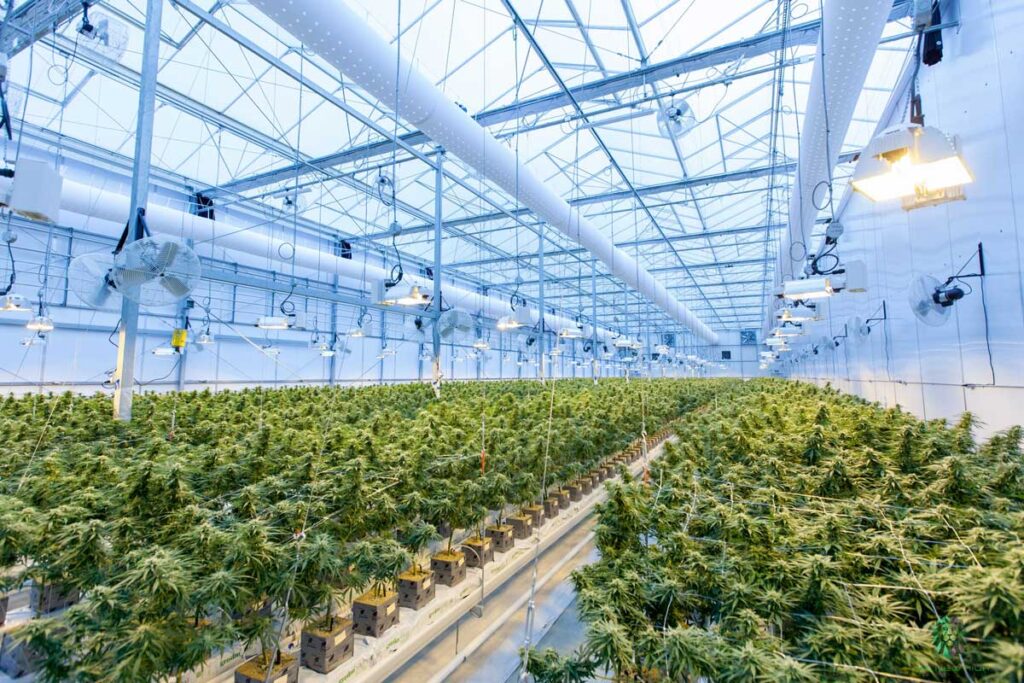
Timing Unknown Strains
If you don’t know the genetics of your strain and you want to use the more precise timing method, you may need to examine the buds daily to find the peak harvest time. Start monitoring and examining your magnified trichomes when 20% to 25% of the hairs on your buds have started to change color. Because the flowering period of the strain is unknown, you’ll want to start on the earlier side of when flowering could be optimal. You’ll need to examine them daily (or at least every other day) until they are ready for harvest.
Pruning Your Cannabis Plants
Cannabis growers can manipulate plants during the growth cycle for bigger yields. One of the easiest and most basic ways to increase yields is by pruning cannabis plants. Pruning involves trimming plants while they’re growing to remove leaves, stems, and buds that aren’t necessary or underproductive, so energy can be refocused to increase growth in other, more successful areas of the plant.
Pruning cannabis while it’s growing helps maximize cultivation space, allowing for more light to reach various areas of the plant for optimal bud growth and development. Fewer leaves mean more light and increased airflow to areas of the plant that otherwise wouldn’t receive it. Pruning is an extremely common practice across the agricultural industry. Vegetable gardeners, for example, might prune tomato plants or peppers in order to increase overall yields.
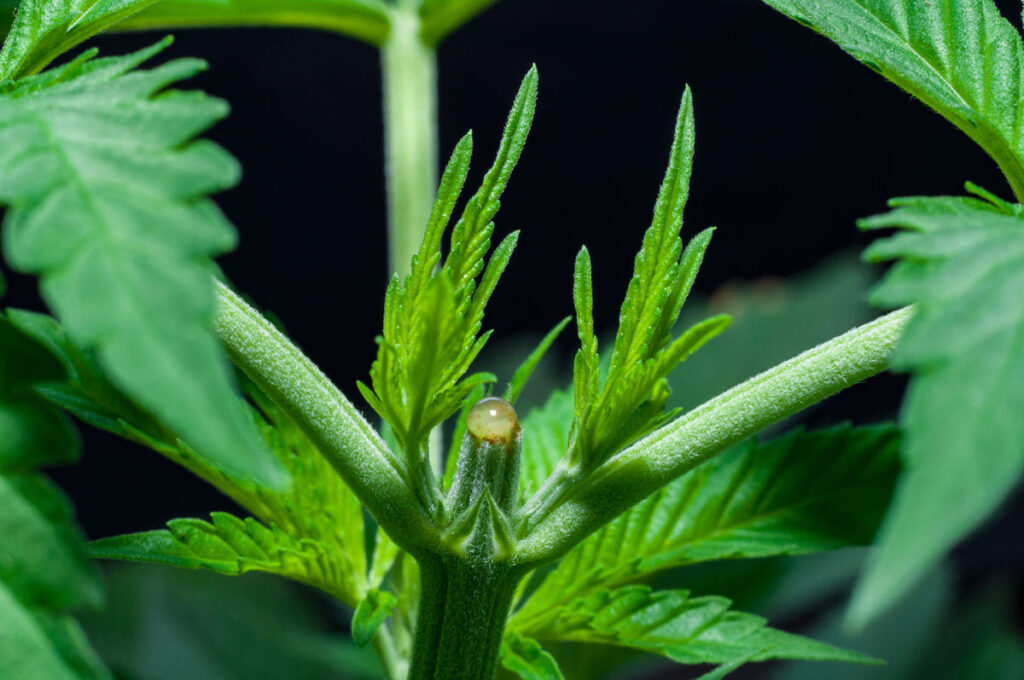
There are several different types of pruning practices, including:
Topping
Topping cannabis involves removing the top of the main stem during the vegetative growth stage. This is one of the best-known and most commonly used pruning techniques, as it creates two branches where there would only be one. Ultimately, this allows for double the growth where only one bud would have grown prior to topping. It also distributes growth hormones throughout branches, which allows them to grow more aggressively. Topping should be done only when plants have reached a height of at least 30 cm.
Lower Branch Trimming
Lower branch trimming, or base pruning, is when the lower branches of the cannabis plant are cut off during the vegetative stage. After the plant has been in the vegetative stage for 3–4 weeks, the two lowest sets of branches can be cut off. This increases airflow to other branches and allows focused energy on bud areas closest to the light. Keep in mind that too much lower branch trimming will cause stress to plants, which is why it’s widely recommended to perform this method in moderation.
FIM
FIM stands for “F*ck I Missed” which is a pruning technique that was discovered by an anonymous grower who accidentally when topping a marijuana plant. FIM pruning involves removing about 75% of the tip of the main stem. The result is four or more main shoots instead of the two you get when topping, which can significantly increase overall yields. As with topping, “FIMing” should be done when plants have reached a height of at least 30 cm.
Lollipopping
Lollipopping is done after plants have started flowering, usually around 3–4 weeks into the flowering stage. This method is ideal for growers using the Sea of Green (SOG) method; SOG allows small grow spaces to achieve the maximum yield. Lollipopping leads to fewer leaves and larger buds, as all the energy is focused on the tops of the flowers. This will ultimately increase the quality and quantity of buds.
Tips For Increasing Cannabis Yield Through Timing and Pruning
In a 2019 meta-analysis, researchers highlighted the main factors that contribute to cannabis yields, which include the variety of cannabis, plant density, light intensity, and nutrients. They also recognized that pot size, the type of light, and the duration of the flowering stage can also predict total yield and THC content.
Genetics are one of the main contributing influences on how much a plant will yield. If you’re interested in increasing your yield, it’s recommended to choose strains that contain a genetic predisposition to produce high yields.
The environment in which plants are grown will also influence yield size. Generally speaking, growers will experience better results when growing indoors as the environment can be manipulated for the most ideal conditions.
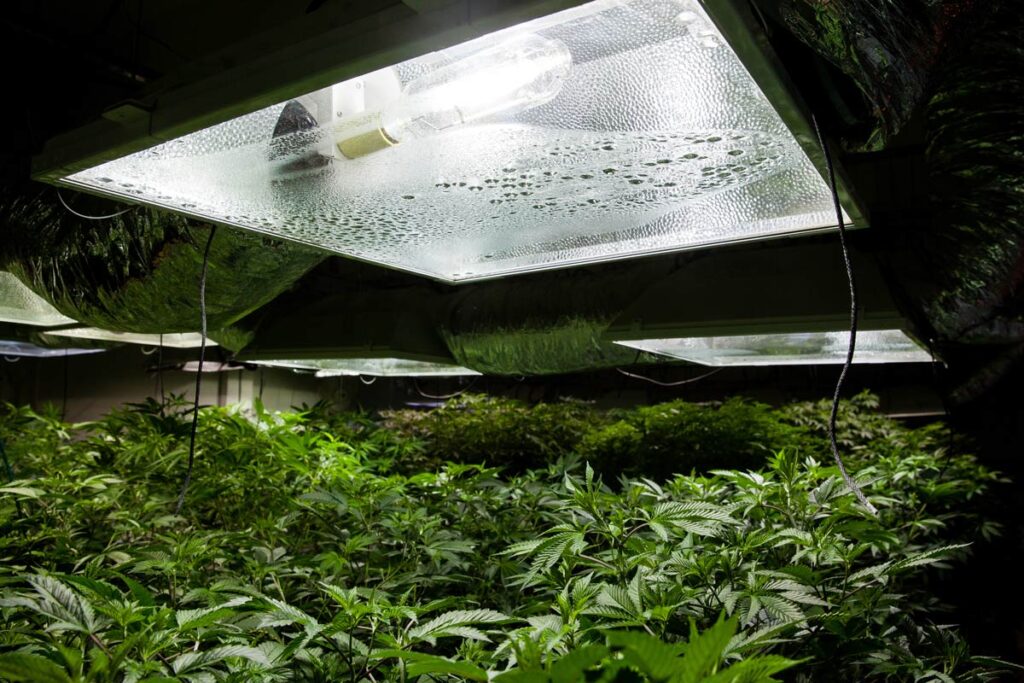
Lighting is one of the most important environmental factors when growing cannabis, and there are several lights designed specifically for cannabis cultivation. HPS (high-pressure sodium) grow lights show to lead to a higher yield than MH (metal halide), which is likely because HPS lights contain a higher luminous efficiency. Typically, more lumens (photons) means higher yields.
Humidity is another major contributing factor to overall yield. Cultivating cannabis indoors allows growers to control humidity during various stages of plant development. The ideal humidity level for the vegetative stage is between 55–70% and 40–60% for the flower stage. Humidity levels should not drop to lower than 40% during the entire growth cycle. Ensuring plants are exposed to ideal humidity levels throughout their lifecycle will contribute to better overall yields come harvest times.
General tips for optimizing growth to increase yield:
- Use HPS grow lights and increase the light intensity. Generally, the more intense the light, the larger the plants and buds will be.
- Manipulate plants through various pruning techniques, such as topping, lower branch trimming, FIMing, etc. Manipulating cannabis plants in this way is referred to as “low-stress training” or “LST” and can significantly increase yields.
- Ensure you’re using the correct nutrients for various stages of plant growth.
- Control the temperature and humidity in your growing environment during each stage of plant growth. If either is too high or too low, it will affect the overall yield.
When pruning and timing cannabis plants to increase yield, there are things growers will want to avoid. Improper light cycles, unbalanced humidity levels, poor soil, using the wrong nutrients, and improper pruning can be devastating to yields. Timing is also critical. Harvest plants too soon, and you risk lower THC levels. Harvest plants too late, and THC levels will have begun to degrade and will be of lower quality.
Final Thoughts on Pruning to Increase Yield
At Triminator, we’re here to help growers increase productivity and profitability in the rapidly expanding cannabis market. If you’re a cannabis cultivator interested in maximizing your harvest for THC and increasing your yield, pruning and timing are two of the most important factors to consider.
The timing of your cannabis plants’ pruning and harvesting is critical. By caring for plants during these various growth stages, growers can increase yields. Removing leaves, stems, and flowers will help refocus energy on other plant areas that increase development.
By manipulating your plants with ideal light intensity, proper humidity levels, and the right nutrients and pruning plants throughout their lifecycle, you can dramatically increase your yields and the quality of your flower.
Contact us today for more information on how Triminator can help maximize your cannabis and hemp harvests.